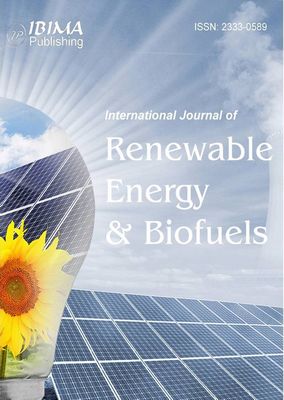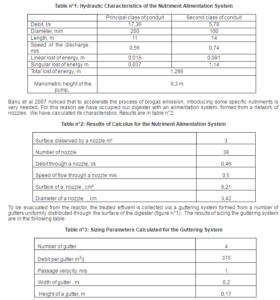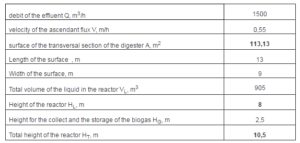Introduction
The valorization of the treated waste water by its reuse in different domains and by producing biogas from the sludge collected is a tendency of all countries at international level and is a solution proposed by experts from all disciplines in order to combat the scarcity of water resources resulting from the climatic change effects, to protect the environment from the pollutants that exist in the waste water if rejected and to found new clean sources of energy (Karthileyan and Kandasamy 2006, Heinz and Zifu 2009, Mahmoud 2002). In fact, as said by Martin 2008, one cubic meter of biogas (60% CH4, 40% CO2) can give heating value as 20-25 MJ with a calorific value of about 6kw/m3 which corresponds to about half a liter of diesel oil. Hence the biogas can be used as an ecologically friendly and future oriented technology at worldwide. Also valorizing the waste water in producing energy from the sludge inside is a very promoting sector for sustainable development. Knowing that at worldwide the number of purification stations to treat the municipal waste water is very high and many industries are occupied with their proper wastewater treatment station. After treatment of that water with the appropriate norm we will obtain an important amount of biomass as sludge. If the treatment stations are occupied with a biogas digester, we can produce from that biomass an energy to be transformed into heat, electricity or both. So we compensate the energy consumption and minimize the operating/maintenance cost if used in the treatment station itself. The rest of energy can be either connected to the national grids or used in the functioning of the sources of waste water as heat or electricity (industries, buildings, houses…). Many works exist in the bibliography (Arsova 2010, Azimi and Zamanzadeh 2004, Banu et al 2007, Gasparikova et al 2005, Lise et al 2008, Mogens et al 2008) which analyze the anaerobic techniques of waste water treatment by calculating the efficiencies and the sizes as function of the waste water characteristics and debit without major insisting on the biogas valorization and without establishing link with thermo-economic calculus for every component of the anaerobic reactor. In this work we will model and conceptualize a biogas reactor that permits both to treat the waste water and to produce methane from that biomass in order to cogenerate from it an important amount of energy as electricity and heat. A thermo-economic analysis to evaluate the efficiency of that digester will be detailed. A case study to size that reactor with a thermo economic evaluation for a waste water issued from a yeast industry installed at the North-West of Tunisia and for a municipal waste water issued from a purification station in Charguia (town in Tunisia) will be realized.
Formulations for Biogas Reactor Conception and Calculus
To conceptualize a high efficient biogas digester that permits to treat the waste water at the same time to produce energy by valorizing the biogas collected, we have to consider the hydraulic scheme of waste water through the reactor components in order to fix the optimal hydraulic retention time and that of rest for the sludge. The optimal yield of methane to obtain from the biomass extracted and the amount of energy to produce with the correspondent equation of calculus linking the time of rest and the chemical demand of oxygen to the biogas emitted is the second part of the approach. Finally we present the appropriate equations permitting to size all components of the digester as function of biomass attracted and methane produced.
Hydraulic Modeling of the Flow through the Digester:
The affluent is introduced from the bottom of the digester it passes through a granular layer with a feeble speed of about 0,5 to 1 m/hour to assume a homogeneity and a full optimal contact with the biomass. The hydraulic pressure inside is determined by applying the Bernoulli theorem between the entering point and any position in the reactor (Punmia and Ashok 2003, Sellami 2012). We can express it by:

Hi: The total charge or pressure at the knot i
jlin,i: The linear lost of pressure at the section i
Li: The length of the section i
Jsing,k: The singular lost of energy in the knot k
The total charge at any section i inside the installation is formulated by:

Zi: Altitude of the point i
Pi: Pressure at the point i
Vi: Speed of the flux at the point i
g: Gravity acceleration
Ï: Volume mass
There is many formulas that express the linear and singular lost of energy and they depend on the roughness of the inner side of the accessories through which the sludge passes and the kind of singularity. They can be represented by the following general forms:

Q: Debit of the waste water
D: Diameter of the tube
β: Coefficient of roughness for the linear lost of energy
ε: Coefficient of singularity
V: Speed of the water flux
n, m: Coefficients characterizing the fluid and the installation
Then we can formulate the hydraulic retention time (HRT) by (Punmia and Ashok 2003, Sellami 2003, Subtil et al 2012):

HRT: Hydraulic retention time
Voldig: Volume of the digester
Qeff: debit of the effluent
This parameter (HRT) gives an indication about the optimal time during which we kip the biomass inside the reactor in order to produce an important amount of biogas in a short period (Gasparikova et al 2005, Venkatesh et al 2013). We define also the biomass retention time (BRT):

Ab-dig: Amount of the biomass in the digester
Ab-eff: Amount of the biomass in the effluent
The time of rest inside the reactor in order optimize its efficiency is:

trest: Time of rest (day)
Ï„gr: Rate of growth (g/g day)
Mnd-CDO: Mass of non degradable chemical demand in oxygen (g/m3)
Fdec: Decadence factor (g/g day)
F1/2sp: Factor of half the speed (mg/l)
The biogas produced is collected at the superior part of the digester and the optimization of the amount collected depends on three principal factors: the composition of the substrate, the time of rest and the temperature inside the digester. To increase the efficiency of the reactor we must propose the size that permits to have equality between the hydraulic retention time and the biomass retention time (Zeeman and Sanders 2001, Azimi and Zamanzadeh 2004, Banu et al 2007).
Energetic Modeling for the Biogas Digester
To model the energetic process inside a digester we must consider the amount of methane to have inside the biogas disengaged. Elmitwalli et al 2002, suggest that the amount of biogas released is directly related to the quantity of biomass to restrict from the waste water. The amount of biomass produced is expressed by the following equation (Lise et al 2008, Mogens et al 2008, Arsova 2010):

Qeff: Debit of the effluent m3/j
Ybio: Biomass yield, gr/gr
Mi-CDO: Initial mass of the chemical demand of oxygen gr /m3
MndCDO: Mass of the non degradable chemical demand of oxygen , gr/m3
Bdeb: Biomass fraction as debris (gr/gr)
Msus: Mass of suspended matter (gr/m3)
Mvol: Mass of volatile suspended matter (gr/m3)
The rate of the suspended matter compared to the total biomass is calculated by the following formula:

Rsus: Rate of the suspended matter (kg/m3)
Volnom: Nominal volume of the waste water in the reactor (m3)
The amount of methane produced is estimated by:

Rmeth: Rate of methane produced
The amount of energy produced is formulated by:

Etot-prod: Total energy produced
Ameth-prod: Amount of methane produced
Dmeth: Methane density
Eprod/gr-meth: Energy produced per gram of methane
Lise et al 2008, Heinz and Zifu 2009 confirmed that for energetic consideration the efficiency of this kind of reactor is directly linked to the methane productivity. So their global yield is defined as the amount of gas produced per gram of organic substance introduced and can be expressed by:

Ymeth-CDO: Yield of methane compared to the chemical demand of oxygen
Ymeth-SM: Yield of methane compared to the suspended matter
Mv-meth: Mass of the methane volume produced
MCDO: Mass of the chemical demand of oxygen
MSM: Mass of the suspended matter
Generally we consider that 95% of the energy restituted from the biogas could be valorized then we can write:

Eval: Valorized energy
From the amount of energy we can valorize we must consider the needed energy for the boiler to heat the mud which is generally evaluated at about 30% from that valorized and the pumping energy. We noticed them by auxiliary energy and we can write:

Eaux: Auxiliary energy
Yb: yield of the boiler
Yt: Yield of the turbine
Ym: Yield of the motor
Jsin,i: Singular lost of energy in the knot i
Jlin,j: Linear lost of energy for the section j between two successive knots
Li-i+1: Distance between two successive knots
∆zi,i+1: Difference of altitude between the knots i and i + 1
The lost of energy through the repartitions of the digester can be by convection and by conduction. Then the total lost of energy can be formulated as follow:

Elost,rep: Total lost of energy through the repartitions of the digester
t: Time
Sk: Surface of the repartition k
Uk: Coefficient of conductivity of the repartition k
∆Tk: Difference of temperature between the repartition k and the exterior
Vollim,l: Limited Volume inside the digester
Cl: Thermal volumetric capacity of the fluid in the limited volume inside the digester
∆Tl: Difference of temperature between the limited volume and the exterior
The energetic balance for the digester can then be written as follow:

Erec: Recovered energy
Eval: Valorized energy
Eaux: Auxiliary energy
Elost,rep: Lost of energy by repartition
The formalism presented in this paragraph consider the energy to produce from the methane emitted when the waste water biomass pass through the digester. Also we have formulated the lost of energy from all repartitions of the digester, the recovered energy and the auxiliary energy when calculating the energetic balance for all reactor compartments. We can then conceptualize our digester with the appropriate size.
Modeling for the Assessment of the Reactor Size’s
Generally to define the optimal size of a biogas reactor we need to know the quantity of biomass to attract from the waste water, the amount of biogas to produce and our real need from energy (heat or electric form). After, as many authors like Lettinga and Hulshoff 1991, Ghangrekar et al 2003, Lew et al 2004, we will use simple formulas linking the input parameters characterizing the waste water flux and the sizes of the reactor to conceptualize.
The total volume of the liquid for the acceptable organic charge inside the reactor is expressed by (Duncan .M 2004, Mogens et al 2008):

Volliq-tot: Total volume of the liquid in the reactor (m3)
Ï„org: Rate of organic charge kg /m3)
Fe: Factor of efficiency
For the transversal surface of the reactor it can be estimated from the following usual formula:

Strans-reac: Transversal surface of the reactor (m²)
Vsp-asc: Velocity of the ascendant flux (m/h)
The height of the liquid in the digester is calculated:

Volgaz-pro: Volume of gas produced
Sdir: Direct surface of the section
The total height of the reactor (H_(tot-dig))is estimated as the sum between the height of liquid in the digester and that for the storage of the biogas produced (H_gas). We can write then:

The expressions of the sizes for all rector compartments will be used to evaluate their direct cost and their indirect costs and to establish the global thermo economic function of the reactor. We will consider all phases: raw material, fabrication, construction, transport, installation, maintenance, functioning and impacts.
Thermo Economic Function for the Biogas Digester
Bejan et al 1996 and Erlach et al 1999 notified that to establish a thermo economic model for an energy system in general we have to distinguish between the direct and the indirect cost and to formulate both of them by considering all the entering parameters. For Frangopoulos 1987, globally, the total thermo economic function depends on three terms for every component of the system studied: the investment (I), operating cost (CO), the maintenance cost (M) and the environmental/social cost. To formulate the precedent cited terms for a system like a biogas reactor we must consider the equipments, accessories, field, constructions, installing work, operating and maintenance, environmental consideration and social impact (Erlach et al 1999, Sellami 2011, 2012).
The economic/social quantification of the environmental effect permits to evaluate the indirect cost when using the biogas digester to cogenerate the energy. It gives to our model a more realistic consideration because it represents the price to pay in order to make back the environment in which exist the installation to its initial situation (Sellami 2010). So we can say that we have considered all the aspects in the thermo economic function. For an annual evaluation a representation of the thermo-economic function for a biogas digester is (Valero 1993, Serra 1994, Ensinas et al 2013):

The different elements in equation (22) are represented as follow:
The global interest considering the life time of every component

The global operating cost for each equipment with its maintenance evaluation

Environmental cost as function of amount of material for every component, emitting rate of the pollutant, size occupied by the equipment, tax applied to every pollutant

The investment expressed as the sum of the function cost associated to every equipment in the reactor

Cai: Equipment Costs
nθ: Equipment number
Ii: Investment for the cost of the installation
F: Factor that characterize the type of material
t:Time (integration over a year)’
i: Interest rate
Ii: Investment of the installed equipment i
ni: Lifetime for the equipment i
ne: Number of the equipment in the installation
CE: The environmental cost
CO(t): Operating cost of the installation
mi(t): Amount of material expressed in Debit unity
Prci,j: Selling prices of the products i and j
E: Electric power
Prc-e: Electricity price
M(t): Annual price of maintenance
á¹j: Output flux j
á¹r: Debit of the resource r
xi,j: Component of the pollutant i in the flux j
xi,r: Emitting rate of the pollutant i per unit of resource r
Taxi: Tax applied to the pollutant i
njpolluant: Pollutant number in the output flux j
nout: Number of emitting flux from the installation
na: Life time of the installation
nh: Functioning time of the installation in hour per year
Se: Size occupied by the equipment e
ne: Number of equipment in the installation
xi,e . Rate of production of pollutant i of the equipment e per unit of size
The thermo-economic analysis presented in this paragraph is very utile to conceptualize every component of the reactor. It utilizes the parameters calculated at the study phase for every compartment detailed above (hydraulic evaluation, energetic evaluation, sizes of all reactor parts) as function of the waste water characteristics. After, we can take the appropriate decision about the conception. In the following paragraphs we will try to apply the modeling approach to yeast industry waste water and to municipal waste water in Tunisia.
A Case Study to Design the Digester for a Yeast Industry in Tunisia
The waste water issued from the yeast industry in general is characterized by a high concentration of organic charge evaluated at more than 5 kg/m3 in unity of chemical demand of oxygen and about 9 kg/m3 in unity of biological demand of oxygen. So if rejected without treatment it can be considered as a real menace to the environment. For our case we will try to conceptualize a bio digester to a yeast industry installed at the north east of Tunisia said. It has as production capacity of about 30 000 tons equivalent humid yeast annually. The debit of waste water issued is about 1500 m3/day with a charge of about10252 mg/l in unity of chemical demand in oxygen (CDO), 8871 mg/l in unity biochemical demand in oxygen in five days (BDO5), 886 mg/l in unity of suspended matter and 486 mg/l in unity of azoth. Annually we can reach a charge of about 5612970 kg for the chemical demand in oxygen and a charge of about 4856872,5 kg for the biochemical demand of oxygen. Knowing that the factory is situated in the village of Ben Béchir, about 6 kilometers from the city of Jendouba, in the middle of a green area and is surrounded by the mountains of R’Bia in the proximity of the historic Bulla Regia not far from the archaeological site of Chemtou. Actually the important amount of waste issued from the plant are rejected without treatment and without valorization in wades and plains surrounding the factory which is very harmful to both the population and the environment (Houcem 2011).
Conceptualizing of the Biogas Digester
The system we are conceptualizing in order to cogenerate electricity and heat from the biogas produced after treating the waste water issued from yeast industry is formed from three important parts: biogas collector (gas-liquid-solid separator, dropping network), tank of sludge, alimentation system (Houcem 2011). A schematic presentation of the digester is in the following figure:
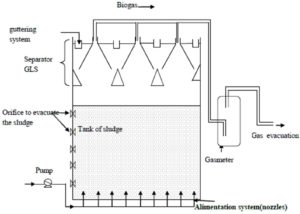
Figure n° 1: A Schematic Presentation of the Digester
We will present after the results of our calculus for sizing every part of the digester by considering the characteristics of the waste water issued from the yeast industry “Rayen Food” and by applying the precedent equations.
Hydraulic Calculus for the Digester
By considering the precedent formulas and the characteristics of the waste water issued from the plant we have calculated the system of conduits for the transfer of the sludge, nutriments and biogas for the digester studied here. A synthesis of our results is in this table:
Table n°1: Hydraulic Characteristics of the Nutriment Alimentation System
Assessment of the Separator Gas-Liquid-Solids Device
In the conception of our digester we have considered the separator gas-liquid-solid, formed from a defined number of conic domes, in order to maintain during all the time of rest an important amount of sludge so we can produce a high quantity of methane at the same time we enable the sludge to slide back into the digester compartment without consumption of external energy or the use of a control system. Also it permits the separation of the biogas and discharging this from the reactor to prevent as efficiently as possible the wash out of viable bacterial matter and floating granular sludge, to serve as a kind of barrier for rapid excessive expansions of a sludge blanket into the settler and to provide a polishing effect. The parameters characterizing the separator were calculated and the principal results are in the following table:
Table n°4: The Parameters of the Separator Gas-Liquid-Solid
Calculus of the Digester Sizes
For the debit of waste water issued from the industry studied which is about 1500 m3/day and by considering all digester compartments we have applied the precedent formulas in order to size of the biogas reactor. Our principal results are in the following table:
Table n°5: Calculus of the Digester Sizes
Energetic Calculus
By applying the equations (8-17) we have calculated the amount of methane produced from the waste water treated. Also we have estimated the energy that we can convert. Principal results are in the table n°6.
Table n°6: Energetic Parameters of the Digester
The different terms of the energetic balance for the biogas digester were calculated and the potential of electric energy we can obtain was estimated. The following table recapitulates our results:
Table n°7: Terms of the Energetic Balance and the Potential of Electric Energy Produced

Calculus of the Economic Efficiency
To model the economic profitability of the digester we will consider as indicated in the equations (21-25) the parameters formulating the direct and the indirect costs.
For the direct cost that forms the global amount of investment we have to evaluate the value of the construction matter (cement, gravel, sand, steel), the equipments of the digester (separator, collector, alimentation system; conduit, candelabra, tanks.…) and the maintenance/operating cost (Nadeem et al 2008). The calculus was done by considering the sizes estimated above. Herewith our principal results:
Table n° 8: Recapitulation of the Total Direct Costs
For the indirect cost we will consider the valorization of the biogas as energy (electric and heat) by cogeneration and the environment enhancement (Heinz and Zifu 2009). The different terms of the energetic balance for biogas digester were calculated and we have estimated the digester electric potential. The evaluation of the cost and the gain realized after valorizing the biogas produced with the time of reimbursing were realized. The following table presents our principal results:
Table n°9: Calculus of the Total Gain with the Compensation Time

We can say that for the industry of yeast the installation of a biogas digester has a net profitability at double sides. The first is to realize an environmental enhancement by avoiding the reject of waste water characterized by a high level of charge. The second is to valorize the biogas produced by cogeneration of heat and electricity which permits to realize a gain of about 119600DT/year and to reimburse the investment in the installation in a period between 6 and 10 years.
Eugenio et al 2006 and Mahmoud 2002, signaled that gain by collecting more methane can be ameliorated if we optimize the variation of the time of rest with the heating temperature. Figure n°2 presents the combined variation of the relative biogas production in % and the time of rest in minute with the heating temperature in °C.
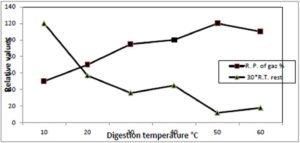
Figure n°2. Theoretical Variation of the Relative Production of Biogas (R.P of Gas in %) and the Relative Time of Rest (R.T.rest in %) with the Digestion Temperature in °C
We see clearly that the relative production of biogas increases with the temperature and is directly linked to the decrease of the time of rest. The relative biogas production reaches a maximum of about 120 % at a temperature of about 50°. By considering the thermo economic function of the digester we can decrease the temperature for a higher biogas productivity.
Energetic Valorisation of the Municipal Waste Water for a Tunisian Town
Charguia waste water treatment station is installed at the industrial zone Charguia 1 It collects a melange between industrial and domestics waste water issued from the town “Tunis” (Aouni 2011, Sellami 2011). Its capacity of treatment is about 60 000 m3/day. An important part of that water is used in many irrigation projects (green space, and citrus fruits). The station was formed from many treatment unities. Filter system, decanting system, aeration systems, reactor for activated sludge and anaerobic reactor. We have calculated the amount of biogas we can produce from the sludge recapitulated after treating the waste water when installing a biogas digester and we have made its thermo economic evaluation by applying the precedent equations. Figure 3 presents the evolution of the biogas energy produced as function of the sludge issued from the waste water.
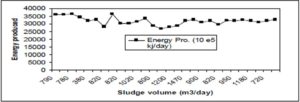
Figure 3. Evolution of the Biogas Energy Produced for Charguia Station
We can say that the amount of energy produced depends on the waste water flow and that it varies between 27 105kj/day and 37 kj/day. The mean monthly energy produced is about 33 105 kj and the yearly energy produced is about 11862500 105 kj/year. If converted to electrical energy it can be evaluated at about 71 GW yearly which means an economic gain of 3266000 DT/year
Conclusion
The industrial waste water can be valorized in many fields by either reusing it in agricultural, industrial and domestic sectors at the same time producing biogas and cogenerating the electricity. We have detailed in this work a modeling approach that permits to conceptualize a biogas digester designed for sludge energetic valorization by cogenerating heat and electricity and to make a thermo-economic evaluation of that reactor. The stapes of modeling are, estimation of the hydraulic retention time, time of rest, concentration of suspended matter, methane produced, determination of the volume and the sizes of all parts of the reactor, energy cogenerated and thermo economic efficiency. Also we have considered the calorific properties of the biogas and the influence of digestion temperature evolution on biogas emission and on the time of rest. Results from two case studies in order to validate the model were detailed. They consist to valorize the biogas produced from the sludge of a yeast industry waste water and of a purification waste water station for a town in Tunisia. Thermo economic evaluation of the biogas produced from the two stations shows that we can realize a gain of about 119600 DT/year for the yeast industry and about 3266000 DT/year for Charguia station with a compensation time of the cost of reactor installation between 6 and 10 years.
References
Aouni, S. (2011). ‘Performance Study of the Charguia STEP,’ Thesis for Engineering Study, ESIER, supervised by M.H.Sellami. E.S.I.E.R (2011)
Appels, L., Baeyens, J., Degre`ve, J. & Dewil, R. (2008). “Principles and Potential of the Anaerobic Digestion of Waste-Activated Sludge,” Progress in Energy and Combustion Science 34 (2008) 755—781
Publisher – Google Scholar
Arsova, L. (2010). “Anaerobic Digestion of Food Waste: Current Status, Problems and an Alternative Product,” S. Degree in Earth Resources Engineering Department of Earth and Environmental Engineering Fu Foundation of Engineering and Applied Science Columbia University, 77 pages
Publisher – Google Scholar
Azimi, A. A. & Zamanzadeh, M. (2004). “Determination of Design Criteria for UASB Reactors as a Wastewater Pretreatment System in Tropical Small Communities,” International Journal of Environmental Science & TechnologyVol. 1, No. 1, pp. 51-57, Spring 2004
Publisher – Google Scholar
Banu, J. R., Kaliappan, S. & Yeom, I. T. (2007). “Treatment of Domestic Wastewater Using Upflow Anaerobic Sludge Blanket Reactor,” International Journal of Environmental Science & Technology, 4 (3): 363-370, 2007
Publisher – Google Scholar
Bejan, A., Tsatsaronis, G. & Moran, M. (1996). Thermal Design and Optimization, John Wiley & Sons, 1996 – Technology & Engineering – 542 pages New York
Publisher – Google Scholar
Elmitwalli, T. A., Oahn, K. L. T., Zeeman, G. & Lettinga, G. (2002). “Treatment of Domestic Sewage in a Two-Step System Anaerobic Filter/Anaerobic Hybrid Reactor at Low Temperature,” Water Research, 36(9), 2225-2232.
Publisher – Google Scholar
Ensinas, A. V., Codina, V., Marechal, F., Albarelli, J. & Silva, M. A. (2013). “Thermo-Economic Optimization of Integrated First and Second Generation Sugarcane Ethanol Plant,” Chemical Engineering Transactions, 35, 523-528 DOI:10.3303/CET1335087
Publisher – Google Scholar
Erlach, B., Serra, L. & Valero, A. (1999). “Structural Theory as Standard for Thermoeconomics,” Energy Conversion and Management 40, 1627—1649.
Publisher – Google Scholar
Foresti, E., Zaiat, M. & Vallero, M. (2006). “Anaerobic Processes as the Core Technology for Sustainable Domestic Wastewater Treatment: Consolidated Applications, New Trends, Perspectives, and Challenges,” Reviews in Environmental Science and Biotechnology 5:3-19.
Publisher – Google Scholar
Frangopoulos, C. A. (1987). “Thermo-Economic Functional Analysis and Optimization,” Energy 12(7), 563—571.
Publisher – Google Scholar
Gasparikova, E., Kapusta, S., Bodík, I., Derco, J. & Kratochvll, K. (2005). ”Evaluation of Anaerobic-Aerobic Wastewater Treatment Plant Operations,” Polish Journal of Environmental Studies Vol. 14, No.1 pp 29-32, 2005
Publisher – Google Scholar
Ghangrekar, M. M., Kahalekar, U. J. & Takalkar, S. V. (2003). “Design of Upelow Anaerobic Sludge Blanket Reactor for Treatment of Organic Wastewaters,” Indian Journal of Environmental Health . 2003 Apr;45(2):121-32
Publisher – Google Scholar
Houcem, M. (2011). ‘Conception and Sizing of an Aerobic Digester and Electric Cogenerating,’ Thesis for Engineering Study, ESIER, Medjez El Bab, Tunisia, supervised by M. H. Sellami. E.S.I.E.R (2011)
Karthileyan, K. & Kandasamy, J. (2006). “Upflow Anaerobic Sludge Blanket (Uasb) Reactor in Wastewater Treatment,” Chapter in the Book, “ Water and Wastewater Treatment Technologies,” Published by UNESCO-EOLSS. Encyclopedia of Life Support System. 19 pages
Publisher – Google Scholar
Khalil, N., Sinha, R., Raghava, A. K. & Mittalc, A. K. (2008). “UASB Technology for Sewage Treatment in INDIA: Experience, Economic Evaluation and its Potential in Other Developing Countries,” Twelfth International Water Technology Conference, IWTC12 2008, Alexandria, Egypt 1411
Publisher – Google Scholar
Lettinga, G. & Hulshoff Pol, L. W. (1991). ‘UASB Process Design for Various Types of Wastewater,’ Water Science & Technology, Vol. 24, No. 8, 1991, pp. 87-107.
Lew, B., Tarre, S., Belavski, M. & Green, M. (2004). “UASB Reactor for Domestic Wastewater Treatment at Low Temperatures: A Comparison between a Classical UASB and Hybrid UASB-Filter Reactor,” Water Science and Technology Vol 49 No 11—12 pp 295—301 © IWA Publishing 2004
Publisher – Google Scholar
Mahmoud, N. (2002). “Anaerobic Pre-Treatment of Sewage under Low Temperature (15oC) Conditions in an Integrated UASB-Digester System,” Ph. D. thesis, Sub-department of Environmental Technology, Wageningen University, The Netherlands.
Publisher
Mang, H-P. & Li, Z. (2009). “Biogas Sanitation for Black Water or Brown Water, or Excreta Treatment and Reuse in Developing Countries,” Technology Review, Edited by: Dr. Elisabeth von Münch, GTZ. Program “Sustainable Sanitation — Ecosan“ of Deutsche Gesellschaft für Technische Zusammenarbeit (GTZ) GmbH
Publisher
Mara, D. D. (2004). Domestic Wastewater Treatment in Developing Countries, First published by Earthscan in the UK and USA in 2004 Copyright © Duncan Mara, 2003 ISBN: 1-84407-019-0
Publisher – Google Scholar
Mogens, H., Markvan, L., George, E. & Damiro, B. (2008). ‘Biological Waste Water Treatment. Principles, Modelling and Design,’ Book published by IWA Publishing, London, Cambridge University Press, 449 pages.
Google Scholar
Punmia, B. C. & Jain, A. (2003). ‘Wastewater Engineering,’ Book edited by Laxmi Publications (P) LTD, 660 pages, (2003).
Sellami, M. H. (2010). ‘Etude de Rentabilité la Réutilisation des Eaux Usées Traitées dans le Domaine Agricole: Défis Économiques, Socio-Psychologiques et Environnementales,’ Cahier INGREF, 14( Numéro spécial), ISSN 1737-0515, (2010) pp.345-354
Sellami, M. H. (2011). ‘Modelling Approach to Valorise the Industrial Wastewater,’ International workshop, Hadrumetum Eco- Industries CITEC 2011 November 10-11-12/2011, Sousse, Tunisia
Sellami, M. H. (2012). ‘Thermo-Economic Modeling of Renewable Energy Systems. Case Study for Wind Farm,’Presented in International Renewable Energy Congress, 19-22 December 2012 Tunisia
Sellami, M. H., Hassen, A. & Sifaoui, M. S. (2003). ”Modelling of UV Radiation Field inside a Photoreactor Designed for Wastewater Disinfection Experimental Validation,” Journal of Quantitative Spectroscopy and Radiative TransferVolume 78, Issues 3-4, (2003) Pages 269-287
Publisher – Google Scholar
Serra, L. (1994). ‘Optimización Exergoeconómica de Sistemas Térmicos,’ Ph.D. thesis. Department of Mechanical Engineering, University of Zaragoza, Spain.
Google Scholar
Subtil, E. L., Cassini, S. T. A. & Goncalves, R. F. (2012). “Sulfate and Dissolved Sulfide Variation under Low COD/Sulfate Ratio in Up-flow Anaerobic Sludge Blanket (UASB) Treating Domestic Wastewater,” Ambi-Agua, Taubaté, v. 7, n. 1, p. 130-139, 2012. (http://dx.doi.org/10.4136/ambi-agua.849)
Publisher – Google Scholar
Valero, A., Serra, L. & Lozano, M. A. (1993). ‘Structural Theory of Thermo Economics,’ Proceedings of the ASME Advanced Energy System Division, AES Vol. 30 (ASME Book H00874). ASME.
Venkatesh, K. R., Rajendran, M. & Murugappan, A. (2013). “Start-Up of an Upflow Anaerobic Sludge Blanket Reactor Treating Low-Strength Wastewater Inoculated with Non-Granular Sludge,” International Refereed Journal of Engineering and Science (IRJES) ISSN (Online) 2319-183X, (Print) 2319-1821 Volume 2, Issue 5(May 2013), PP.46-53
Publisher – Google Scholar
Wafler, M. (2008). ‘Training Material on Anaerobic Wastewater Treatment,’ Version 3, December 16th, 2008, published by Second International gmbh Switzerland and Ecosan Services Foundation (ESF) India, 39 pages
Google Scholar
Zeeman, G. & Sanders, W. (2001). “Potential of Anaerobic Digestion of Complex Waste (Water),” Water Science and Technology Vol. 44 No 8 pp 115—122, IWA Publishing 2001.
Publisher – Google Scholar



